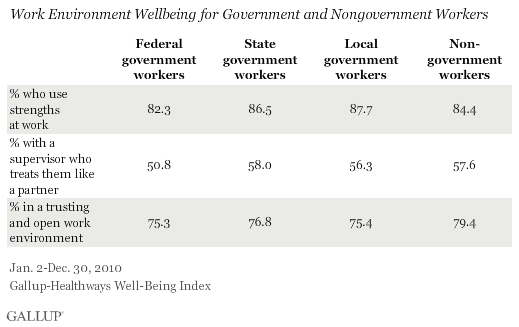WASHINGTON, D.C. -- Employees of federal, state, and local government agencies enjoy somewhat higher overall well-being than U.S. nongovernment workers. State and local government employees also have slightly higher well-being than federal workers.

The close nature of the overall well-being scores among these groups obscures significant differences within the six specific areas of well-being measured.
Government employees outperform nongovernment workers the most in the areas of overall life evaluation and access to basic needs such having enough money to pay for healthcare and/or medicines, provide adequate shelter or housing, and buy food; and having health insurance and a personal doctor. Federal, state, and local workers also generally exhibit better emotional health and healthier behaviors than do nongovernment workers.
A key distinguishing factor, however, between federal employees and all other employee groups -- state, local, and nongovernment workers -- is their much lower work environment well-being. While state, local, and nongovernment workers had roughly the same workplace well-being in 2010, federal workers lagged behind with a Work Environment Index score of 42.2.

These findings were collected throughout 2010 as a part of the Gallup-Healthways Well-Being Index. For more information on what each sub-index comprises, see page 2.
Federal Employees Struggle With Relationships With Their Supervisors
Federal workers' lower workplace well-being is primarily the result of more negative relationships with their supervisors. The Work Environment Index contains four items, one of which asks respondents if their supervisor treats them more like a boss or a partner. Among federal workers, 50.8% say their supervisor treats them more like a partner. This compares with 57.6% of nongovernment workers, which is about on par with state and local government employees.
The Work Environment Index also asks workers if they are satisfied with their jobs, if they get to use their strengths at work, and if their supervisor creates an environment that is open and trusting. All three types of government workers are somewhat less likely than their nongovernment counterparts to say their supervisor fosters an open and trusting workplace.
Additionally, federal workers are less likely than state and local government employees to report getting to use their strengths at work, though the large majority still indicate that they do.

Bottom Line
While government employees sustain modestly better overall well-being relative to nongovernment U.S. workers, federal workers lag behind in workplace well-being. In particular, these workers are less likely to have positive relationships with their supervisors. The lower percentage of federal employee respondents who experience a partnership relationship with their supervisors indicates a more traditional, subordinating work environment for this group. For leaders of federal agencies, therefore, encouraging partnerships between managers and employees represents a key opportunity area for improving their labor force's well-being.
About the Gallup-Healthways Well-Being Index
The Gallup-Healthways Well-Being Index tracks U.S. and U.K. well-being and provides best-in-class solutions for a healthier world. To learn more, please visit well-beingindex.com.
Survey Methods
Results are based on telephone interviews conducted as part of the Gallup-Healthways Well-Being Index survey Jan. 2-Dec. 30, 2010, with a random sample of 183,992 working national adults, aged 18 and older, living in all 50 U.S. states and the District of Columbia, selected using random-digit-dial sampling. Of these working adults, 151,221 respondents were nongovernment workers.
For results based on the total sample of national adults, one can say with 95% confidence that the maximum margin of sampling error is ±0.2 percentage points.
The maximum margin of sampling error for government employee groups is larger, but still small. There are 7,486 federal employee, 14,132 state employee, and 11,153 local employee respondents in the sample over the 12-month surveying period, yielding a margin of sampling error range of about ±1 percentage point.
State, federal, and local government employees are defined via the following questions: "Do you currently work for the federal, state, or local government?" If yes, "Which one?"
Active duty military personnel are excluded from the definition of federal employees.
Interviews are conducted with respondents on landline telephones and cellular phones, with interviews conducted in Spanish for respondents who are primarily Spanish-speaking. Each sample includes a minimum quota of 400 cell phone respondents and 600 landline respondents per 1,000 national adults, with additional minimum quotas among landline respondents for gender within region. Landline telephone numbers are chosen at random among listed telephone numbers. Cell phone numbers are selected using random-digit-dial methods. Landline respondents are chosen at random within each household on the basis of which member had the most recent birthday.
Samples are weighted by gender, age, race, Hispanic ethnicity, education, region, adults in the household, and phone status (cell phone only/landline only/both, cell phone mostly, and having an unlisted landline number). Demographic weighting targets are based on the March 2010 Current Population Survey figures for the aged 18 and older non-institutionalized population living in U.S. telephone households. All reported margins of sampling error include the computed design effects for weighting and sample design.
In addition to sampling error, question wording and practical difficulties in conducting surveys can introduce error or bias into the findings of public opinion polls.
For more details on Gallup's polling methodology, visit www.gallup.com.

